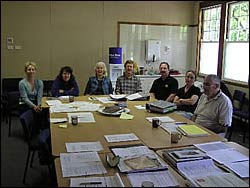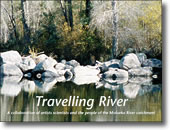Arts & science collaboration
Research Status: Past |
Arts-science project team |
Introduction
The Mountains to the Sea initiative was a collaboration of scientists and artists drawn together to find new ways of understanding and conveying ideas about the environmental and social interconnections that shape the Motueka Catchment. It was carried out in conjunction with the Integrated Catchment Management research programme.
Such "SciArt" initiatives are a relatively new phenomenon and an extension of growing interest in bringing divergent disciplines together to encourage new insights and discoveries.
The genesis of the project was in October 2002 with a Landcare Research sponsored workshop of artists and scientists looking for common ground and ways of collaborating using talents in research, environmental understanding and creativity. Following this workshop, the Mountains to the Sea proposal was put to the pilot "Smash Palace" arts and science dialogue fund supported by the Ministry of Research, Science and Technology and Creative New Zealand, and was part-funded along with two others from a pool of 23 applications.
Mountains to the Sea involved biophysical and social science researchers from Landcare Research and two Nelson-based independent artists. It has drawn on environmental research undertaken in the Motueka River Catchment to pose the questions: What is integration and how does our understanding of integration influence the management of a catchment?
The aims of this project were twofold:
(1) to better understand how those from different disciplines can successfully work together, but foremost
(2) to produce a collaborative work that conveys and promotes an understanding of the integrated nature of the Motueka Catchment environment.
The Travelling River Exhibition was the major outcome of the Mountains to Sea Arts-Science collaboration.
Research Approach
The first part of this project was to find common ground between the artists and scientists involved. We further developed this common ground by talking to one another about the catchment, exploring the different ways we think about it and discussing what joint projects could be worked on to achieve our second goal. To do this we have used a shared web-based workspace where all group members can drop in with their ideas and comments.
An important part of our work is to develop some understanding of the way nature and culture form our environment and to learn about the catchment, its communities and its history. In 2005 we published a book Conversations about a River comprising sections of the web-based dialogue.
The second phase of the collaboration took the understandings gained through this dialogue to a wide and participating community audience through a 'Travelling River' exhibition.
The exhibition was held in two locations during 2004 - the Suter Gallery in Nelson (opening August 6, 2004) and in the Motueka catchment itself, at Motueka Museum in December 2004.
Travelling River combined over 250 community photographs, science images and stories from the Motueka catchment. More than sixty people contributed images and stories about their lives or their science along the river and Tasman Bay, into which it flows. The exhibition was organised around extracts from Motueka Song, by local poet Cliff Fell, Montana Book Award’s poet in 2004. The exhibition was a “creative collision” between science, art and community aspirations for the Motueka catchment. The exhibition engendered lively debate among the more than 2500 visitors, building understanding of our science and encouraging people to think about how their environment has been modified by human and natural actions.
The project team comprised Maggie Atkinson and Suzie Peacock (Nelson artists), and Landcare Research scientists Andrew Fenemor (leader of the Motueka Integrated Catchment Management research programme), Margaret Kilvington, Chrys Horn and Chris Phillips. It developed understanding of the extensive local knowledge and the sense of place that exist among communities in rural catchments like the Motueka. Above all, it built trust for furthering our integrated catchment management (ICM) research.
Research Results
The Travelling River Exhibition was the first "output" of the Mountains to the Seas project. Travelling River is a journey of exploration down one river network to the sea. It is an exploration among scientists working with nature and the people who have lived and worked along those watercourses. Art is both the platform upon which this collaboration is built and a stimulus for thinking in new ways, wherever in our interactions we desire to go. The exhibition explored life and science in the Motueka River catchment and out into Tasman Bay, where the impacts of the Motueka River are still felt. Twenty-four panels each present intersections of community photographs and a chosen science theme, and are organized around extracts from Cliff Fell’s work in progress Motueka Song.
The web-based dialogue that the Arts-Science team used to communicate and share ideas formed the basis of "Cultivating conversations about a river" - a booklet of some of those conversations.
An evaluation of our project was carried out by Sian Ede of the UK's Gulbenkian Foundation an Arts & Science expert who evaluated this and two other projects as part of the overall Smash Palace project. Our Mountains to the Sea project was presented in Wellington at Te Papa on Tuesday 23 March 2004. In addition, the two social scientists in the project also carried out an evaluation of the project and have produced a report.
Mountains to the Sea: Reflections on an arts and science collaboration about the Motueka River Catchment.
 |
 |
Sian Ede at MoRST presentation |
Travelling River exhibition catalogue |
Recent Publications
BMPs, BEPs and Guidelines
| Title | Description |
| The Tool Kit: A planning tool for community consultation and quality decision making in local authorities |
From document: The tool kit guides Local Government managers and elected representatives throu...More » |
| Tourism Planning Toolkit For Local Government |
From website: The Tourism Planning Toolkit is a set of tools to help local authorities plan fo...More » |
| Heritage Management Guidelines for Resource Management Practitioners |
From Guide: Guidelines on sustainable management of historic heritage to promote understanding...More » |
Primary Contacts:

|
Andrew Fenemor
Email Phone: 03 545 7710 More details» |
Institute Landcare Research |
Expertise ICM programme management; local liaison; resource management; hydrology and water resource management |

|
Margaret Kilvington
Email Phone: 03 3256700 Fax: 03 3252418 More details» |
Institute Landcare Research |
Expertise collaborative learning, facilitation, evaluation |